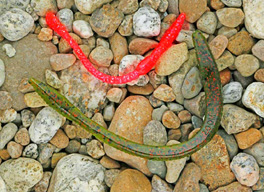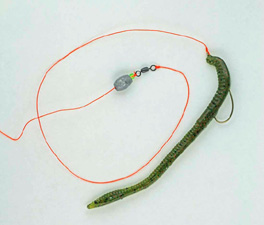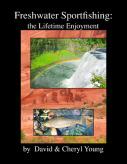Carolina Rig

The Carolina Rig is perhaps my favorite plastic worm rig. It allows one to fish through heavy structure and weed beds without catching much moss and weeds.
To rig, pass your line through an egg sinker and then pass it through a small bead and tie the end to a barrel swivel. I like black swivels better than nickel. An improved clinch, Trilene or B.C. Knot is effective. To the opposite end of the swivel, I tie on the leader with the same selected knot. I prefer a fluorocarbon leader of ten or twelve pound test. I use about eighteen inches to four feet of leader. At its end I tie on a worm hook with the same knot. Next I usually use an eight inch worm but a shorter one can be selected. I then hook the worm onto the hook Texas style. That is, the hook point passes through the head of the worm and passes out to the side. About one inch or so of the worm is imbedded into the hook. I pull the head of the worm over the hook eye. This makes the rig weed less. Finally, the worm is rotated 180 degrees and the hook is embedded again into the worm. But the hook’s point is buried. This is to prevent weeds from becoming attached. The curve in the worm’s anterior causes it to seductively wiggle on the retrieve.
I fish the rig by casting it out and carefully watching it as it sinks. I allow it to sit on the bottom for about thirty seconds. Next, I lift the rod slowly up from the ten o’clock to the high noon position. I drop the rod tip back down to the ten o’clock position and reel in some line. I let it fall back down to the bottom. I repeat this process until the rig is retrieved.

The bass usually takes when the worm is falling. Sometimes they will move over and pick it up while it’s lying on the bottom. Fish it slowly and cast to all areas where you suspect a fish may be waiting. The bite is very light and usually I set the hook when the line moves. You must be fast to set it because the fish usually rejects the worm as soon as it detects that it’s not real bait. A scented worm may be helpful in tricking the bass into holding the bait longer before it rejects it.
This method accounts for my largest bass caught during the warm summer months.

© 2025 The Gale Group, Inc. All rights reserved.
© 2025 Perigee Learning LLC. All rights reserved.
LoveTheOutdoors.com is owned and operated by Advameg, Inc. © 2025 Advameg, Inc.
Camping Adventures • Dutch Oven Cooking • Sports Knots
Fly Tying • Freshwater Fishing • Fly Fishing

